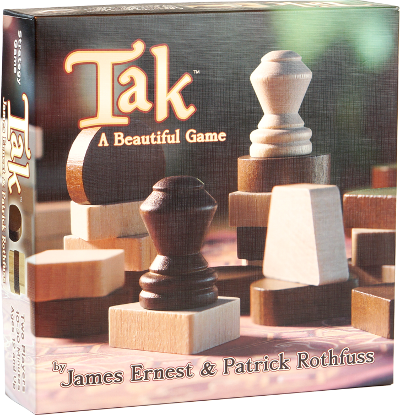Every once in a while you find a game that absolutely has everything you want.
Tak is one of those games for me.
Over on Board Game Geek (BGG) I created a ‘geeklist’ for the best abstract strategy games of the current decade, and Tak slots in at number two, right behind Arimaa and in front of Yinsh.
I also have a ‘top-100’ list at BGG and Tak slots in at number three behind crokinole and Arimaa.
So, yes, I love this game. But what is Tak?
Well, Tak is a board game which was originally mentioned in Patrick Rothfuss’ bestselling novel, The Wise Man’s Fear.
Rothfuss eventually teamed with James Ernest, a games designer with a range of game creation credits, to create the actual game.
The goal of Tak is to build a road, which is a string of pieces that connects opposite sides of the board. A road does not have to be a straight line. Diagonal spaces do not connect.
In general, connection games don’t generally excite me, but this one captured my imagination from the outset.
There are only two types of pieces in Tak: stones and capstones Stones can be played in only two ways: flat or standing, so the basic rules are very simple, like many of the best abstract strategy games.
Usually, stones are played flat, and it is flat stones that can stack. It’s also the only time pieces that count as part of a road, which of course is the goal.
When you place a stone on end as a standing stone, then nothing can be stacked on it. Standing stones don’t count as part of your road.
A standing stone is generally a way to slow an opponent, and as a result they are often called walls in the game.
Capstones (a player may have one or two depending in the size of board being played on) combine the best aspects of standing and flat stones: they do count as part of a road, but they can’t have another piece stacked on top.
In addition, a capstone by itself has the power to flatten a standing stone, which can be useful to remodel a wall into a road piece.
Play is very simple. You can place a flat stone, a standing stone, or your capstone in any empty space on the board. You never play a piece directly on another one. Stacks only form because of movement.
You can move one or more pieces in a stack that you control. A ‘stack’ of pieces can be any height, including just one piece. Control means that your piece is on top.
To move the stack, take any number of pieces off the top, up to the carry limit, and move them in a straight line, dropping at least one piece off the bottom in each space along the way. So in its simplest form one piece can move atop an adjacent flat single piece, or pile.
Taller stacks can move further, dropping pieces as they go.
There is no limit to the height of a stack, but there is a limit to the number of pieces that you can move. This “carry limit” is equal to the width of the board, so for example in a 5x5 game, you can carry no more than five pieces. That means if you start with a stack of seven, you must leave at least two of those pieces in the starting space.
Tak, which can be played without a board (although having one delineates the play area nicely), is generally played on boards 4x4, up to 8x8, although as a quirk not on 7x7. The larger the board, the greater the challenge is.
For a quick game, you opt for a small board. longer games require a longer board. You also get a second capstone and more pieces on a large board.
The pieces are wood, so that is aesthetically pleasing. They’re also nicely sized in the two versions I have seen, so Tak is highly tactile as well.
Everything with this game is wonderful from the simple rules, the in-game strategy, and the joy of success. A true gem.
Check it out at www.cheapass.com/tak.




